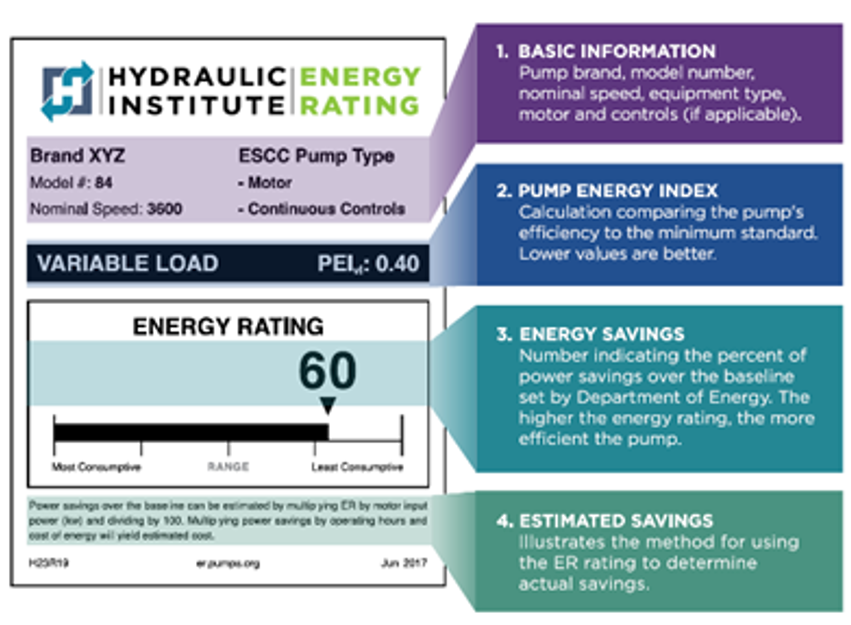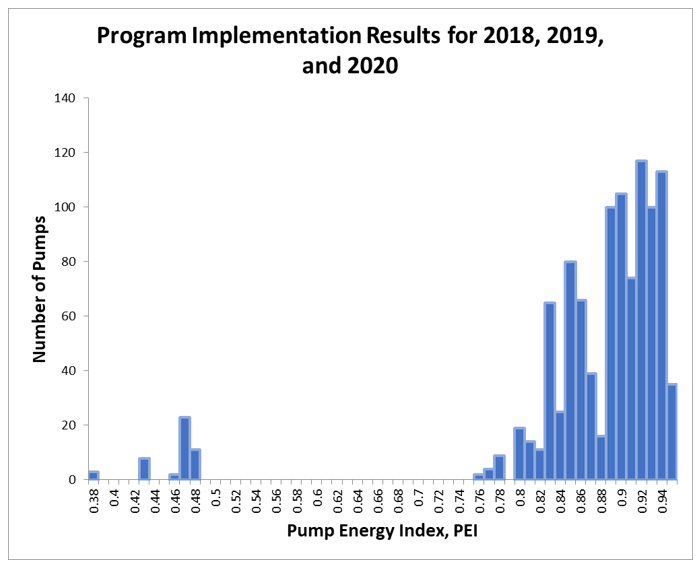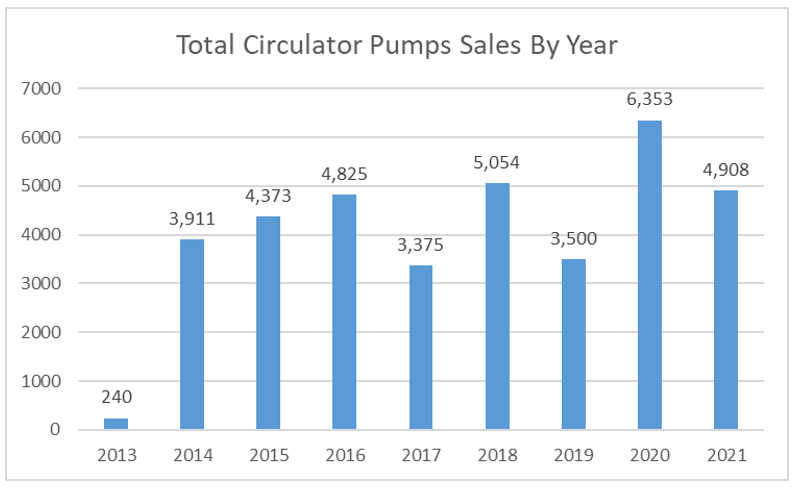Changing Midstream Behavior to Boost Energy Efficient Pump Sales
Energy organizations and utilities are learning how to leverage DOE regulations, pump efficiency labels, and utility programs to speed the adoption of high-efficiency pumps.
Category: Blogs, Energy Efficiency, PSM Newsletter September 27, 2022
Energy organizations and utilities are learning how to leverage DOE regulations, pump efficiency labels, and utility programs to speed the adoption of high-efficiency pumps.
How is the transformation to high-efficiency pumping systems going? At the American Council for an Energy-Efficient Economy’s (ACEEE) summer study, the Consortium for Energy Efficiency (CEE), Hydraulic Institute staff and co-authors from other organizations provided an update in the form of a technical paper.
First, though, consider the scope of the opportunity. In U.S. manufacturing, pumps accounted for nearly 27 percent—155,000 GWh—of industrial electricity use in 2006, according to the U.S. Department of Energy. This is why the United States and Canada created regulations to improve efficiency by at least 30 percent for certain types of clean water pumps. In the United States, the DOE began enforcing those rules in 2020. It has published a test procedure for circulator pumps and is likely to issue a regulation covering energy consumption for circulator pumps in 2022.
To encourage industry to invest in energy-efficient pumps, the CEE launched its Commercial and Industrial Pump Systems Initiative. Aided by its member utilities, pump manufacturers, and the Hydraulic Institute, its goal was to establish a voluntary efficiency specification to support the adoption of more efficient pumps.
While efficient pumps may cost more, they achieve significant savings in energy and money over their lifetimes. Unfortunately, these economics are often difficult to communicate, especially when the people selecting and installing the pumps are not the pump system owner. To overcome that barrier, several tools have been developed to help explain the advantage of efficient pumping systems. Here is a summary (a full listing is available here):
DOE Pump Energy Index. PEI is an index for constant load and variable load pumps that represents relative power consumption to a standard. The lower the number, the better.
CEE Definitions. A clear definition of a high-efficiency pump. CEE defines it as PEI 0.95 or less for constant load pumps and PEI of 0.48 or less for variable load pumps.
Hydraulic Institute Energy Rating. ER is based on PEI, but presents it represent the percent power savings over the standard level. In this case the higher the number, the better. The ER label simplifies pump comparisons and provides information to help users calculate energy and cost savings.

Hydraulic Institute ER Database. The ER Database contains more than 12,000 individual pump models. The database list contains only pumps that have undergone a third-party audit in a certified laboratory.
Hydraulic Institute Energy Saving Calculator. The www.pumps.org website includes a tool that enables users to calculate potential savings for an efficient pump by considering operating conditions and utility rates. This makes it easier to compare the upfront costs and lifecycle savings.
Training Classes. HI and Pump Systems Matter have developed in-person and online classes to teach the fundamentals and also more advanced topics as pump system assessment and optimization to improve pump system lifecycle performance.
These tools provide several benefits. They give owners and users a way to quantify electricity consumption and cost. They help sales representatives to communicate life cycle savings. They give utilities and energy efficiency organizations a reliable public database for developing incentive programs. They enable manufacturers to differentiate their products and meet organizational energy efficiency objectives. And, perhaps most importantly, they reduce the carbon footprint of pumping systems.
The paper looked at how three organizations used these tools to advance energy efficiency.
The Northwest Energy Efficiency Alliance. The NEEA Extended Motor Products (XMP) program focused on smart pumps, which include a pump, a variable speed drive, internal sensors, and pre-programmed controls. NEEA identified several barriers to smart pump use, including lack of customer awareness, lack of availability, uncertainty about performance, and high initial cost.
Since it could not reach everyone, NEEA focused on working with eight of the leading manufacturers’ representatives in the Northwest. These participating midstream firms earn incentives for selling efficient products, bonuses for large-scale changes in their sales mix, funding to support customer-oriented initiatives. Pump sales reps have used those funds to make videos, promote efficient products, create lunch-and-learn sessions, put on training events, reach out to contractors and commissioning agents, and stock enough efficient pumps so they are ready when needed.
Between summer 2019 and the end of 2021, NEEA provided more than $600,000 in incentives for more than 9,000 pumps and circulators. Together, these pumps saved approximately 4,700 MWh of energy. In 2021, smart pumps sales rose to 19 percent of total commercial pump sales, from 18 percent in 2020. Smart circulators reached 17 percent, from 13 percent in 2020.
Pacific Gas and Electric. PG&E ran a clean water efficient pump program for new construction and retrofits from 2018 to 2020. It worked with two major distributors. Program incentives were based on performance, equipment family, and nominal speed. To qualify, constant load pumps required a 0.94 Pump Energy Index (6 ER) or better, while variable load pumps needed to meet 0.52 PEI (48 ER) or better.
Between 2018 and 2020, PG&E’s program implemented 1,042 projects, primarily familiar or low-cost pumps for large commercial buildings. As illustrated in Image 2, only 6 percent were variable load pumps (far left of image 2). Based on these results, the program design did not tap into the substantial savings opportunity of variable load pumps. PG&E is now modifying its program to adopt programs that differentiate efficient pumps, use wire-to-water metrics, and engage distributors to reach commercial, industrial, and agricultural customers.

Efficiency Vermont. Efficiency Vermont launched its circulator pump program in 2012, before federal standards existed, but placed only 20 to 30 pumps per year. This was because customers and contractors usually bought pumps based on the best match with their failed pump, local availability, and lowest initial cost. Rebates for efficient pumps were too small to even bother filing.
So, Efficiency Vermont changed its program. For larger clean water pumps, it created a “structured custom incentive” for a small list of qualified pumps with integral controls and variable speed drives. It also paid suppliers a fee for processing the order. Since efficient circulators have higher margins, incentivizing their sales encouraged suppliers to stock more units, which reduced availability concerns.
Since 2013, sales of high efficiency circulators rose from 240 units in 2013 to 4,825 pumps in 2016 and 6,353 pumps in 2020. By 2022, Efficiency Vermont’s midstream circulator pump program included five manufacturers and 253 qualified pumps with sizes up to 3 hp. About 80 percent of sales went into residential markets.

When the DOE set a federal minimum efficiency standard for clean water pumps, Efficiency Vermont recognized a new opportunity to revamp its circulator program. It plans to add clean water pumps to its offerings and use CEE work products to shift from benchmarks created in-house to the new national standards.
Conclusions.
Efficiency Vermont, PG&E, and NEEA have all taken different routes to market transformation with high-efficiency pumping systems. These systems clearly save operating dollars over the lifespans, but educating and incentivizing customers to buy them remains a challenge. This is not surprising for programs that are only a few years old. Their strong start suggests that we are just beginning to see a shift to high efficiency pumping. To review the full paper presented at the 2022 ACEEE Summer Study click here.
SUBSCRIBE TODAY
Get the latest pump industry news, insights, and analysis delivered to your inbox.
